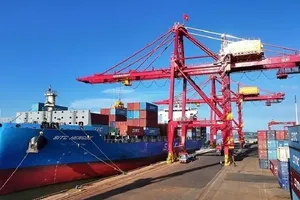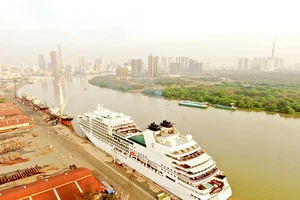 |
Ba Ria-Vung Tau strives to become a logistics hub in the southeastern region by 2025. (Photo: SGGP) |
Trang said the total warehouse supply in Hanoi and Ho Chi Minh City is only around over 2.02 million sq.m and 5.13 million sq.m, respectively. Industrial parks and logistics facilities in major urban areas, especially in the two cities, are experiencing high occupancy rates, with some reaching nearly 100 percent. The demand for warehouse space is expected to continue growing in the future.
She said Vietnam is strategically located next to the economic corridor in southern China, which includes prominent regions such as Shanghai, Shenzhen, Fuzhou, and Guangdong chosen as the headquarters of major industrial, chemical, trade, and electronic technology companies.
On the other hand, Vietnam's industrial parks have welcomed investment from global electronics companies early on, such as Panasonic (1971), LG Display (1995), Canon (2001), Foxconn (2007), Samsung (2008), Fuji Xerox (2013), and more recently, conglomerates like Pegatron, Goertek, Jinko Solar. Vietnam is currently presented with the opportunity to elevate the value of the manufacturing supply chain.
According to the Ministry of Transport, Vietnam has a total road length of 595,201 km, with 25,560km designated as national highways. The expressway network has been expanded to 1,239km, with roughly 14 new routes and sections under construction, equivalent to 840km.
The national railway network spans 3,143km, with 277 stations and two routes linking with China from Dong Dang and Lao Cai. Particularly, the northern region has road, waterway, and rail routes directly to Shenzhen, known as China's Silicon Valley, making it easier for enterprises to expand and allocate production in the area.
Vietnam's seaport system has received significant investments in recent years, with modern facilities that meet international standards, notably Hai Phong and Ho Chi Minh City container ports among the top 50 largest in the world. The seaport system comprises 286 port berths, with a total quay length of over 96km.
For the first time, shipping companies have been able to provide direct services from Vietnam to North America and Europe without the need for transshipment through regional hubs like Singapore or Hong Kong (China), helping save some US$150-300 per TEU for containers traveling to and from Vietnam.
The Vietnamese Government has targeted meeting demand for export-import, trade between regions and areas nationwide, as well as cargo transit and passenger transport both domestically and internationally by 2030.
With attractive conditions in place, experts at Cushman & Wakefield said Vietnam has the potential to compete with global logistics hubs such as Dubai (United Arab Emirates) and Hong Kong (China), and even with Singapore and Shanghai (China), not only aspiring to become a global cargo transit hub but also a vital link in the global manufacturing supply chain.
In the first eight months of this year, the total FDI poured into Vietnam hit nearly US$18.15 billion, up 8.2 percent year on year.
























